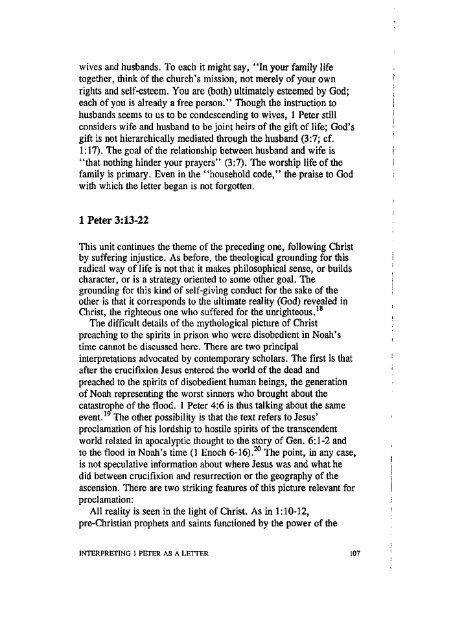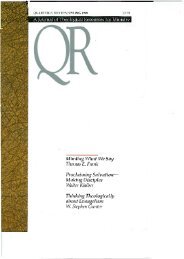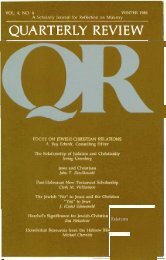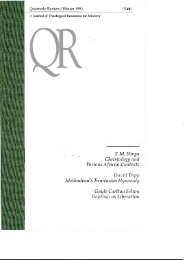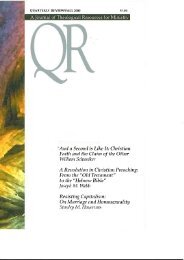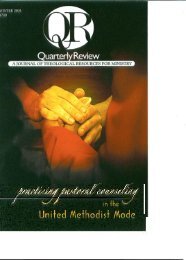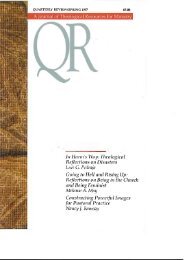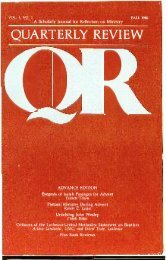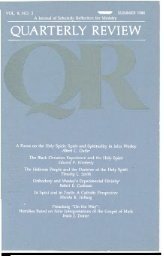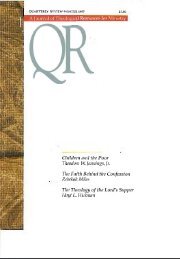TJieodore W. Jennings, Jr. The Meaning of ... - Quarterly Review
TJieodore W. Jennings, Jr. The Meaning of ... - Quarterly Review
TJieodore W. Jennings, Jr. The Meaning of ... - Quarterly Review
You also want an ePaper? Increase the reach of your titles
YUMPU automatically turns print PDFs into web optimized ePapers that Google loves.
wives and husbands. To each it might say, "In your family life<br />
together, think <strong>of</strong> the church's mission, not merely <strong>of</strong> your own<br />
rights and self-esteem. You are (both) ultimately esteemed by God;<br />
each <strong>of</strong> you is already a free person." Though the instruction to<br />
husbands seems to us to be condescending to wives, 1 Peter still<br />
considers wife and husband to be joint heirs <strong>of</strong> the gift <strong>of</strong> life; God's<br />
gift is not hierarchically mediated through the husband (3:7; cf.<br />
1:17). <strong>The</strong> goal <strong>of</strong> the relationship between husband and wife is<br />
"that nothing hinder your prayers" (3:7). <strong>The</strong> worship life <strong>of</strong> the<br />
family is primary. Even in the "household code," the praise to God<br />
with which the letter began is not forgotten.<br />
1 Peter 3:13-22<br />
This unit continues the theme <strong>of</strong> the preceding one, following Christ<br />
by suffering injustice. As before, the theological grounding for this<br />
radical way <strong>of</strong> life is not that it makes philosophical sense, or builds<br />
character, or is a strategy oriented to some other goal. <strong>The</strong><br />
grounding for this kind <strong>of</strong> self-giving conduct for the sake <strong>of</strong> the<br />
other is that it corresponds to the ultimate reality (God) revealed in<br />
Christ, the righteous one who suffered for the unrighteous. 18<br />
<strong>The</strong> difficult details <strong>of</strong> the mythological picture <strong>of</strong> Christ<br />
preaching to the spirits in prison who were disobedient in Noah's<br />
time cannot be discussed here. <strong>The</strong>re are two principal<br />
interpretations advocated by contemporary scholars. <strong>The</strong> first is that<br />
after the crucifixion Jesus entered the world <strong>of</strong> the dead and<br />
preached to the spirits <strong>of</strong> disobedient human beings, the generation<br />
<strong>of</strong> Noah representing the worst sinners who brought about the<br />
catastrophe <strong>of</strong> the flood. 1 Peter 4:6 is thus talking about the same<br />
event. 19<br />
<strong>The</strong> other possibility is that the text refers to Jesus'<br />
proclamation <strong>of</strong> his lordship to hostile spirits <strong>of</strong> the transcendent<br />
world related in apocalyptic thought to the story <strong>of</strong> Gen. 6:1-2 and<br />
to the flood in Noah's time (1 Enoch 6-16). 20<br />
<strong>The</strong> point, in any case,<br />
is not speculative information about where Jesus was and what he<br />
did between crucifixion and resurrection or the geography <strong>of</strong> the<br />
ascension. <strong>The</strong>re are two striking features <strong>of</strong> this picture relevant for<br />
proclamation:<br />
All reality is seen in the light <strong>of</strong> Christ. As in 1:10-12,<br />
pre-Christian prophets and saints functioned by the power <strong>of</strong> the<br />
INTERPRETING 1 PETER AS A LETTER 107


